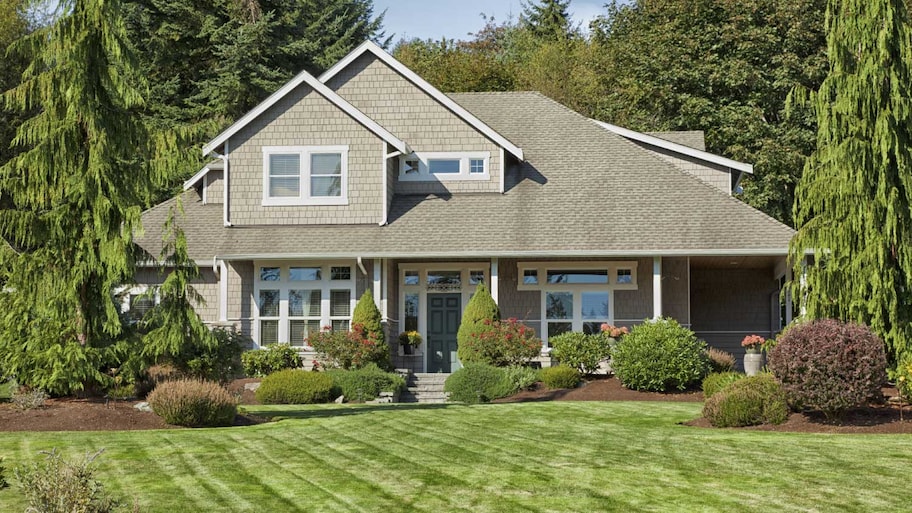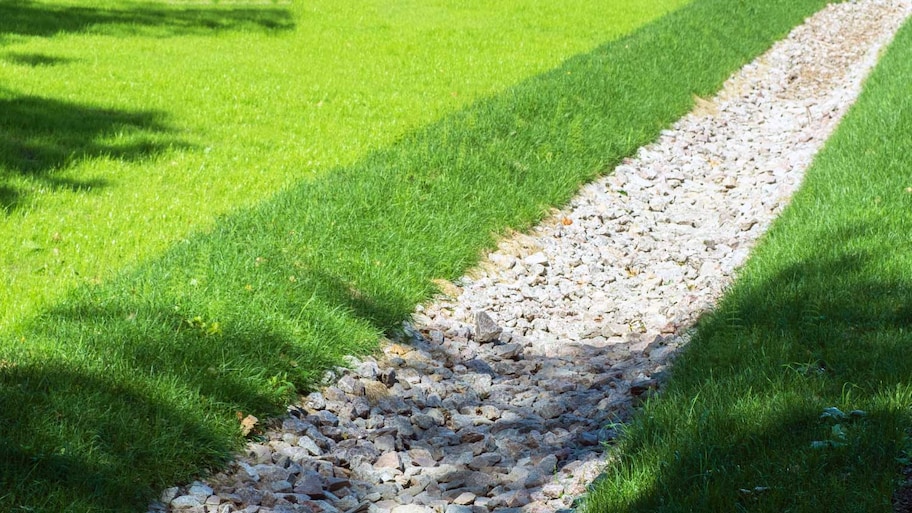How Much Does It Cost to Install a Drainage System In Your Yard? [2024 Data]
Normal range: $2,122 - $7,105
The average cost to install a yard drainage system is $4,612, but this project can range from as low as $800 for small-scale fixes to $15,000 for full-scale solutions.


The average cost to install a drainage system in a yard is $4,612, though most homeowners spend between $2,122 and $7,105. The installation cost ranges between $30 to $40 per linear foot, depending on the type of drainage system. You can expect to pay additional costs for correcting soil grading or placing new grass in the yard. This guide can help you plan for a new drainage system, no matter the budget.
- Average
- $4,612
- Low end
- $800
- high end
- $15,000
Yard Drainage System Cost Breakdown

The cost of materials and labor ultimately determines the price of what you see on your final bill.
Yard Size
Drainage systems for larger yards require more materials and labor, driving up the total cost. Expect installing a drainage system in your yard to cost between $10 and $100 per linear foot. It largely depends on the type of drain and the depth. The closer to the surface, the less you’ll spend on excavation.
Type
There are all different types of drains for your yard—from French drains to underground downspouts and catch basins—and price varies by type. A French drain costs $10 to $100 per linear foot, while a trench or channel drain system costs $30 to $100 per linear foot.
Systems Needed
Drainage systems sometimes require multiple components to function properly. Even if you install a French drain, you may need to install a catch basin to prevent overflow. The more components, the higher the cost.
Materials
The material cost of your drainage system depends on which type of system you’re installing. Yard inlets cost about $50 each, while the materials needed for a French drain (pipe, gravel, sump pump) can run up to $1,500.
Site Prep
There’s usually some site prep required before installing a drainage system. It depends on what’s causing the pooling water or flooding. You may have to hire someone to regrade your yard or build a retaining wall. In other cases, it means breaking up and clearing concrete, trees, and existing landscape features.
Here’s what you can expect to spend:
Regrading a yard costs: $1,025–$3,300
Retaining walls cost: $3,200–$9,200
Land clearing costs: $1,400–$6,050
Concrete removal costs: $550–$1,700
Labor
Hiring a professional to install a yard drainage system will cost between $50 and $100 per hour. Most projects take 12 to 72 hours, bringing your total cost to $600 to $7,200. The time it takes to complete the installation depends on the type of drain you’re installing. Concrete catch basins take the longest to install, while yard inlets take the shortest.
Permits
When plumbing or excavation is involved, you’ll need a permit. Expect to spend anywhere from $400 to $2,300, depending on the job size.
When you hire a landscaper, they typically handle permitting. Either way, make sure you or your contractor call 811 before digging to ensure the project won’t interfere with underground utilities.
Geographic Location
Geographic location can impact your total cost. You’ll spend more on yard drainage in areas with a higher cost of living (and therefore higher labor costs).
Cost to Install a Drainage System by Type
Once you hire someone who does drainage work, they’ll help you choose the best drain system for your yard. Certain systems are more costly than others: Yard inlets and French drains are among the most affordable.
| Type of Drain | Cost |
|---|---|
| French drain | $10–$50 per linear foot |
| Trench or channel drain | $30–$100 per linear foot |
| Underground downspout | $200–$2,000 each |
| Yard inlet | $50–$100 each |
| Concrete catch basin | $2,000–$5,000 each |
| Plastic catch basin | $200–$500 each |
French Drain
A French drain consists of a pipe that’s dug into a ditch to divert water from basements or yards, usually sending it to a storm drain or a sewage system. French drains cost an average of $10 to $50 per linear foot. However, the price differs based on where the French drain is located.
Complex French drain installations, like ones installed near the edge of your house, can cost up to $100 per linear foot. Installing a French drain against your house often involves excavating to the base of a foundation and adding a sump pump to remove excess water.
French drains are relatively simple drainage systems that you can install yourself as long as you’re willing to put in time and energy. But if you’re not comfortable with laying your own pipe or digging trenches, leave the dirty work to a professional French drain company near you.
Trench or Channel Drain
Trench or channel drains typically cost between $30 and $100 per linear foot, but more complex installs, like drains that run underneath driveways, cost about $150 per linear foot. The total price tag of the trough or channel will vary depending on its length and the type of material used.
These types of drainage systems collect and disperse runoff over a large area, and then move the water through an underground drainage system, similar to an underground gutter system.
If you’re installing your trench or channel drain in your concrete driveway, consider calling in a professional. Installation requires you to break up concrete with a jackhammer before installing a surface drain and then repouring and leveling the concrete. After the intensive installation process, the results—proper driveway drainage—will please you.
Underground Downspout
True to its name, these drainage systems are downspouts placed underneath your lawn. Underground downspouts cost between $200 and $2,000 each. The premise of this yard drainage system is simple: The downspouts direct water away from the perimeter of your home and into a municipal drain or sewer.
Installing an underground downspout requires a lot of manpower—there’s intense digging and pipe connecting involved. For the average homeowner, hiring a pro is a better idea than DIY. A professional can install the downspout quickly and correctly.
Yard Inlet
At $50 to $100 per unit, yard inlets are one of the most cost-effective yard drainage system options on the market. Plus, they are sold at most hardware stores. Yard inlets consist of a surface grate and subsurface piping that you can install just underneath the soil surface to reroute water away from your yard. This tactic prevents your yard from becoming waterlogged and muddy.
Yard inlets are fairly easy to install yourself, which makes them even more budget-friendly. But some units are heavier than others, so grab a partner to help you dig a hole and place the inlet in your yard.
Concrete Catch Basin
Concrete catch basins cost $2,000 to $5,000 per unit, including connections and installation. This type of drainage system isn't common on residential properties, especially homes built after 1960, because they accommodate older sewer systems that have a single-pipe system. Catch basins can adequately separate contaminants, so consider installing one if you live in a community with a single-pipe sewer system.
Concrete catch basins are installed lower than the bottom of the street’s sewer system. A grate sits over the top, allowing runoff from your yard to flow into the catch basin, away from your yard, and into a nearby stream or water source. Since concrete catch basins are very heavy and require a lot of manpower to move, hire a professional to install one.
Plastic Catch Basin
Plastic catch basins are essentially a less expensive version of concrete catch basins, costing between $200 and $500 each. This type of drainage system sits below your downspout and separates contaminants, like leaves and large debris, and diverts the water to a storm sewer system or a dry well.
Plastic catch basins are relatively lightweight, which means they’re easy to install. However, they need to be placed underground. If you’re an experienced DIYer or a landscaper who isn’t afraid to get your hands dirty, this shouldn’t be a problem. But for a more hands-off project, hire a professional who specializes in this type of drainage system.
Ongoing Expenses of Yard Drainage Systems
Yard drainage costs aren’t limited to the installation. Your system will also need regular maintenance and occasional repairs.
Maintenance
You’ll need to maintain your drainage system. While you can clean around it on your own, sometimes systems will get clogged. Clearing a clog costs $300 to $700, depending on the complexity.
Repairs
If your drainage system needs repairs, expect to spend $50 to $100 per hour on labor. The total cost depends on the exact repair. Even if the job is small, many plumbers charge a minimum fee of $100 to $250 for the visit. Sometimes, this is called a diagnostic fee or service call fee.
Cost to Install a Drainage System Yourself
If you’re looking to cut down on project expenses, you can attempt to install a yard drainage system using a DIY drainage kit. A complete DIY installation will cost between $100 to $2,000, depending on the type of drainage kit. Although they eliminate labor costs, DIY drainage system kits are risky. If you level your drainage system incorrectly, it won’t solve your water issues.
In order to install an in-ground drainage system by yourself, you need to have a basic understanding of what’s causing your drainage problem, as well as how the drainage system works.
If you don’t have the time or know-how to DIY, consider hiring a local drainage installation professional to install your yard’s drainage system.
Cost of Common Add-Ons for Draining System Installation
A handful of add-on jobs might be required as part of your drainage system installation. This ranges from water removal to repairing landscaping and hardscaping disturbed during the installation.
| Common Add-On | Average Cost |
|---|---|
| Standing water removal | $1,600–$6,575 |
| Landscaping | $1,275–$6,050 |
| Driveway sealing | $110–$1,500 |
| Walkway repair | $1–$15 per square foot |
Standing Water Removal
Standing water removal costs $1,600 to $6,575. Most homeowners install a drain in their yard due to drainage issues, so there’s often a little (or sometimes a lot of) standing water. Contractors will have to drain the water before they begin installing your system.
Landscaping
Most landscaping projects cost between $1,275 and $6,050. After drain installation, you may want to clean up your landscaping. Excavation projects make a mess—and it’s a great opportunity to upgrade.
Some homeowners opt to simply fix their existing landscaping, like installing sod or mulching over areas disturbed by excavation. Others choose to redesign the landscaping around their house to prevent flooding.
Driveway or Walkway Repairs
Installing a drain under a driveway or walkway means repairs such as reinstalling concrete or replacing landscape curbing become necessary. Here are some common costs:
Patching holes: $100–$500 per patch
Filling cracks: $1–$3 per linear foot
Sealing a driveway: $110–$1,500
Leveling an uneven driveway: $650–$1,775
Replacing concrete slabs: $6–$15 per square foot
Landscape curbing costs: $15–$20 per linear foot
How to Save Money on Landscape Drainage System Installation
Drainage system installation can feel like a large project, but it can save you money in the long run despite the upfront price tag. Nobody wants to spend on constant repairs from flooding and water damage. Regardless, there are ways you can save money on this specific project:
Keep the dirt and use it elsewhere: Drain installation requires excavation. Instead of paying to haul the dirt away, see if you can use the dirt somewhere else in your yard.
DIY the small stuff: While you may not be able to DIY a drainage system, you may have the skills to DIY other jobs during installation. For example, you can clear your yard, remove standing water, do some of the demolition, or repair landscaping. Jobs like planting flowers in mulch or laying down grass seed are especially DIY-friendly.
Combine drainage work with other landscaping jobs: It often takes less labor to combine similar jobs than to do them individually, which can save you cash. Sometimes, contractors will even cut a deal on multiple projects. For example, if your driveway is already nearing the end of its life span and you have to tear it up to install a drain, you might as well get a new driveway.
Get contractor quotes: There are a number of pros you can call to solve your drainage problems, but you should shop around to get an idea of local pricing. Get quotes from at least three different contractors to help understand what’s a good value. Always check references and reviews. If a price is significantly lower than the others, it’s often too good to be true.
How Angi Gets Its Cost Data
Home is the most important place on earth, which is why Angi has helped more than 150 million homeowners transform their houses into homes they adore. To help homeowners with their next project, Angi provides readers with the most accurate cost data and upholds strict editorial standards. We’ve surveyed thousands of real Angi customers about their project costs to develop the pricing data you see, so you can make the best decisions for you and your home. We pair this data with research from reputable sources, including the U.S. Bureau of Labor Statistics, academic journals, market studies, and interviews with industry experts—all to ensure our prices reflect real-world projects.
Want to help us improve our cost data? Send us a recent project quote to [email protected]. Quotes and personal information will not be shared publicly.
Frequently Asked Questions
The process is different for each type of drainage system. But no matter your drainage system type, you’ll have to start by digging a hole or trench. To install an effective French drain, for example, you’ll need to dig a trench, line it with filter fabric, pour gravel inside, hook up pipe connections, set the pipe, and cover it with gravel.
You can use shovels or rent a trencher, depending on the size of the trench or hole you’re digging. You generally don’t need a permit from the city to install a drainage system on your own property, but if the work involves changing a structure or electrical work, contact your municipality to check the requirements.
When installing your yard drainage system, consider the slope of your property. Drainage trenches must slope away from your yard by at least a 1% slope to drain properly.
Also, consider how much water you need to drain. If your yard holds a lot of water in the winter, consider installing multiple drains to keep the area dry efficiently. Each municipality has different limits for how much water you can drain off your property.
Before digging, always call 811. Even if you’re only digging a few inches, you could sever a gas or sewage line. A cut line is a serious safety hazard.
Since you’ll likely be digging a trench to install your yard drainage system, this is a good time to complete other tasks that involve digging up your yard, including:
Regrading your yard
Redesigning your landscaping
If your drain is under a walkway or driveway, your contractor must also remove those materials. This is a great time to consider upgrading your hardscaping features, especially if they’re nearing the end of their life span.
